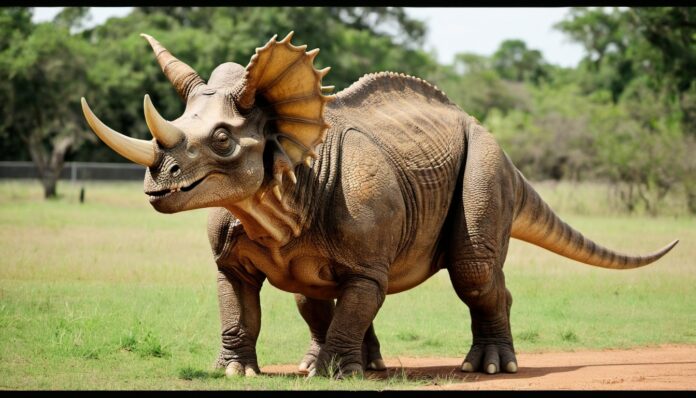Triceratops was a large, plant-eating dinosaur that lived during the late Cretaceous period, about 68 to 66 million years ago. It is easily recognized by its three distinctive facial horns and the large bony frill at the back of its head.
These features were likely used for defense against predators and possibly for display or social interactions. Triceratops walked on four sturdy legs and had a beak-shaped mouth to help it crop plants.
Interesting Facts About Triceratops
- Time Period: Triceratops lived about 68 to 66 million years ago during the late Cretaceous period.
- Name Meaning: The name “Triceratops” means “three-horned face.”
- Location: Fossils have been primarily found in North America, especially in the western United States and Canada.
- Length: Triceratops could grow up to 30 feet long.
- Height: It stood about 10 feet tall at the shoulders.
- Weight: Triceratops weighed around 6 to 12 tons.
- Horns: It had two large horns above its eyes and one smaller horn on its nose.
- Frill: The large bony frill at the back of its head was likely used for protection and display.
- Diet: Triceratops was herbivorous, feeding on plants like ferns, palms, and cycads.
- Beak: It had a sharp, parrot-like beak for cropping plants.
- Teeth: Triceratops had rows of teeth designed to chew tough plant material.
- Social Behavior: Some evidence suggests Triceratops may have lived in groups.
- Defense: Its horns and frill were used for defense against predators like Tyrannosaurus rex.
- Skull: Triceratops had one of the largest skulls of any land animal, up to 8 feet long.
- Brain Size: Despite its large size, Triceratops had a relatively small brain.
- Posture: Triceratops walked on all four sturdy legs.
- Speed: It was likely a slow mover due to its heavy body.
- Discovery: The first Triceratops fossil was discovered in 1887 by John Bell Hatcher.
- Species: There are two recognized species: Triceratops horridus and Triceratops prorsus.
- Hatchlings: Fossil evidence shows that Triceratops hatchlings were significantly smaller than adults.
- Growth: Triceratops grew rapidly from a hatchling to a full-sized adult.
- Fossil Sites: Significant fossil sites include the Hell Creek Formation in Montana.
- Combat: Evidence suggests Triceratops used its horns in combat with other Triceratops.
- Extinction: Triceratops went extinct about 66 million years ago during the Cretaceous-Paleogene extinction event.
- Cultural Impact: Triceratops is one of the most well-known and popular dinosaurs in popular culture.
- Skin: Fossilized skin impressions show that Triceratops had a rough, scaly texture.
- Eggs: Like other dinosaurs, Triceratops is believed to have laid eggs.
